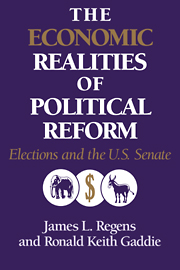Book contents
- Frontmatter
- Contents
- List of tables and figures
- Acknowledgments
- Abbreviations
- Introduction
- 1 The Senate in transition and campaign finance
- 2 Early money and profit taking in Senate campaigns
- 3 Targeting rent provision by major interests
- 4 Sitting in the cheap seats?
- 5 Implications for campaign-finance reform
- 6 Reform and the rent-seeking legislature
- Notes
- Bibliography
- Index
4 - Sitting in the cheap seats?
Published online by Cambridge University Press: 18 December 2009
- Frontmatter
- Contents
- List of tables and figures
- Acknowledgments
- Abbreviations
- Introduction
- 1 The Senate in transition and campaign finance
- 2 Early money and profit taking in Senate campaigns
- 3 Targeting rent provision by major interests
- 4 Sitting in the cheap seats?
- 5 Implications for campaign-finance reform
- 6 Reform and the rent-seeking legislature
- Notes
- Bibliography
- Index
Summary
Campaigning is getting more expensive for everyone.
Richard F. Fenno The United States Senate: A Bicameral PerspectiveThe previous two chapters have documented the conditions that affect rent acquisition and rent retention by U.S. Senators. The amount of money that changes hands in Senate campaigns is substantial and is driven by the electoral needs of incumbents. Interest groups often give based on partisan and ideological grounds. In this chapter, we assess the impact of spending on Senate elections. Contrary to popular belief and unlike the phenomenal reelection rates enjoyed by House incumbents, tremendous turnover has occurred in the U.S. Senate. Table 4.1 reveals that from 1951 to 1993 the number of first-term Senators elected in a Senate class fell below 20 percent on only three occasions: 1961, 1983, and 1991, and went over 35 percent on ten occasions. In 1981, over half of incumbent Senators were serving their first term and 18 were newly elected. From 1981 through 1993, approximately one of every four Senators in each election class were freshmen. Between 1980 to 1992, 64 of the 231 elections held (27.7 percent) sent a new Senator to Capitol Hill. In fact, only 40 of the U.S. Senators holding office in 1993 served in the Senate before the administration of Ronald Reagan; and a number of incumbents opted not to seek reelection in 1994 for various reasons.
- Type
- Chapter
- Information
- The Economic Realities of Political ReformElections and the US Senate, pp. 72 - 85Publisher: Cambridge University PressPrint publication year: 1995



